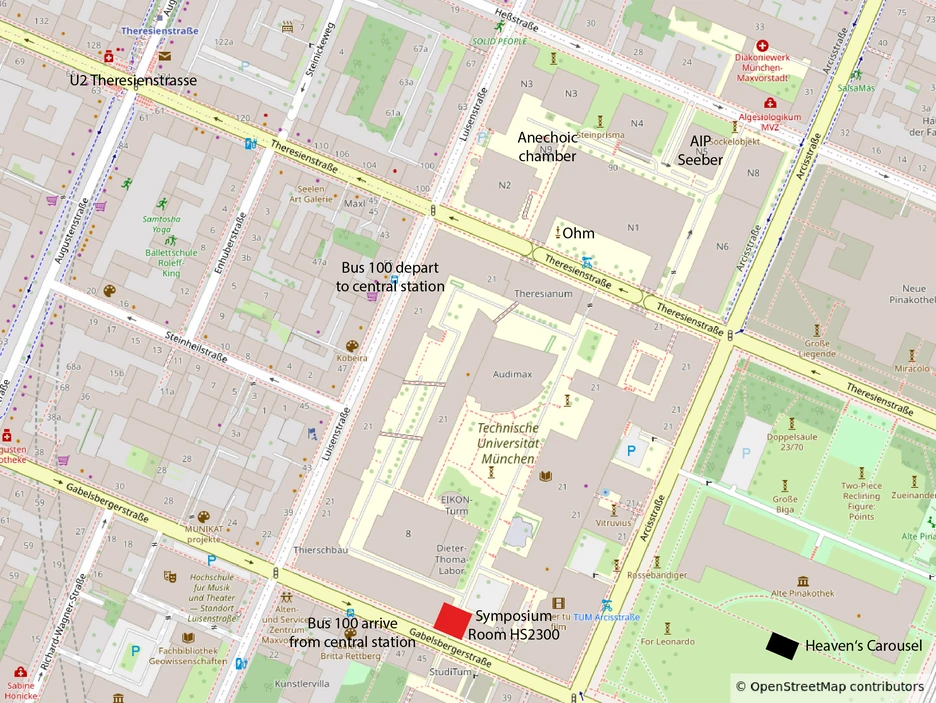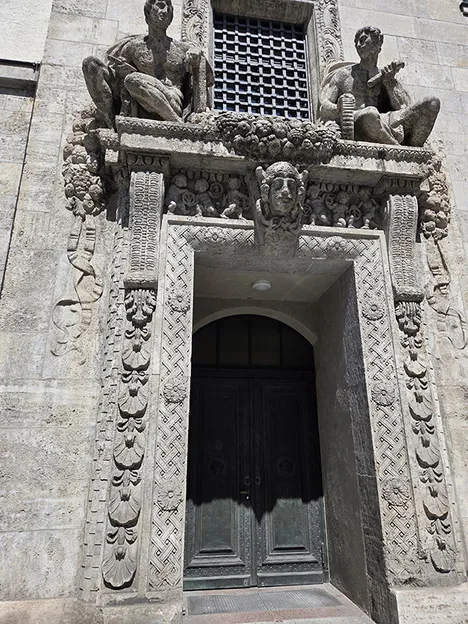
International Symposium, 4-5 July 2025, Technical University of Munich
Joined in the Sonic Revolutions art installation and program, the transdisciplinary symposium “Turning Space” will discuss aspects of space, movement and the emerging source separation, pitch perception and spatial and dynamic re-synthesis of sounds with recognized researchers in the fields of psychoacoustics, neuroscience, cultural studies and artists. Through sessions of two 25-min talks with a moderated discussion, the transdisciplinary symposium will create a network across the boundaries of the natural and cultural sciences and the arts and exchange knowledge and experience both from fundamental sciences and methods applicable in the arts. The emergence and representation of movement in audiovisual art will be highlighted in a public evening event. Attendance is free. We are looking forward to you joining the symposium and discussion!
Quick links
Registration (link to stream will be sent automatically)
Friday 4 July 2025 - Afternoon
14:00 h Welcome & Introduction (Bernhard U. Seeber & Tim Otto Roth)
14:05 - 15:20 h Session 1 Locating Auditory Objects in Space
Where and how do we localize sounds? Beyond the processing of binaural cues, the session focusses on contributions from learnt knowledge about sources, on context from room acoustics and the dynamic evolution of spatial relations of sound objects. But also perceptual ‘metaphysical’ varieties are taken into consideration.
Varieties of Spatial Hearing
Dr Nicola Di Stefano
Institute for Cognitive Sciences and Technologies (ISTC), Rome, Italy
Attention for hearing in space
Prof. Annie Moulin
Equipe Perception Attention Mémoire, Centre de recherche en Neurosciences de Lyon, France
moderator: Prof. Bernhard U. Seeber (Audio Information Processing, TU München)
15:30 - 16:45 h Session 2 Acoustic mobilization – the challenge of kinetic sound objects
How can we can handle the dynamics of sound events? Pierre Schaeffer, who established the Musique concrète with his tape-recording pieces, coined the term ‘objet sonore’. What are sound objects in art or the natural world and what are the challenges when they start to move?
Sound in space: pushing the limits of auditory motion perception
Dr Cédric Camier
Saint-Gobain Research Paris, Coda dptm, Acoustic team, Center of Interdisciplinary Research of Music and Media Technology, Montréal, Canada
Sound objects in natural space – from psychoacoustics to natural space perception
Prof. Christian Lorenzi
Experimental Psychology, Ecole normale superieure, Paris, France
moderator: Dr Antoine Bourachot (Audio Information Processing, TUM)
16:45 h Coffee Break
17:15 - 18:30 h Session 3 Acoustic turn: The impact of Fourier, Ohm & Helmholtz
What are the foundations of a modern hearing culture? The findings of Fourier, Ohm & Helmholtz underly not only the modern understanding of acoustics, but also triggered a paradigm shift in natural and cultural science. The session discusses this turn to a “thinking with sound” and modern ways for sound analysis.
Analyzing the musical scene
Prof. Meinard Müller
International Audio Laboratories Erlangen, Friedrich-Alexander-Universität Erlangen-Nürnberg, Germany
When Sound Meets Self: Defining Acoustic Space in the late 19th Century
Prof. Viktoria Tkaczyk
Media and Knowledge Technologies, Humboldt University, Berlin, Germany
moderator: Prof. Bernhard U. Seeber (Audio Information Processing, TU München)
20:00 h Evening Panel – public & in German, live captioning in English +++ no registration needed +++
Curtain up for the loudspeaker: Sound art in the tension field between installation, art and music theater
Prof. Helga de la Motte-Haber
Systematic Musicology, Technical University Berlin, Berlin, Germany
Prof. Florian Hecker
sound art, Akademie der Bildenden Künste München, Munich, Germany
Sabine Schäfer
composer, sound art/media art, Karlsruhe, Germany
moderator: Dr Tim Otto Roth
Saturday 05 July 2025 - Morning
9:00 h meet & greet over coffee
9:15 - 10:30 h Session 4 In and out of Neuronal Tune: Spatial Intonation
How does the brain shape our sound experience? The neuronal system pieces together auditory objects from tonotopically separated information. Pitch and temporal information is crucial for forming objects while the spatial evolution of the scene and the source’s timbre help us follow sources over time.
Pitch and timbre: Insights from behavioral and neuroimaging studies
Prof. Andrew Oxenham
Psychology, University of Minnesota, USA
Perception of pitch, interval and contour: Insights from music and deficits
Prof. Barbara Tillmann
Université Bourgogne Europe, CNRS, LEAD UMR5022, 21000, Dijon, France
moderator: Dr Julia H. Schröder (Freie Universität Berlin, Germany)
10:30 h Coffee Break
11:00 - 12:15 h Session 5 Birth of Electroacoustic Music: From Interruption to Mobilization
What are the foundations of sound synthesis and its artistic consequences? Already in 1837 Charles Grafton Page sketched an early form of an electroacoustic loudspeaker, which revolutionized with some latency music and the work with acoustic space in the 20th century.
From cybernetics to complexity in ecosystemic musical practice
Dr. Dario Sanfilippo
Vienna, Austria
Thinking Pure Tone Waves – additive synthesis from Ohm to Stockhausen and beyond
Virgile Abela
Marseille, France, associated artist to MAS Plateform LMA-ECM-CNRS-AMU & Laboratoire Modulaire, ESAM
moderator: Dr Tim Otto Roth, imachination projects, Oppenau
12:15 h Closing discussion & farewell
from 12:30 h Demonstration of the interactive audiovisual research space “real-time Simulated Open Field Environment” of the Audio Information Processing group in the anechoic chamber, building N9, Theresienstrasse 90.
Registration
Both in-person and online attendance are for free, but require a registration. Please register at https://ers.mytum.de/ahDXMHXL/
No registration is required for the public evening event.
Location & Getting there
Room 2300 “Friedrich von Thiersch”, Gabelsbergerstrasse, 80333 Munich
Use Bus 100 from the Central Station to “Gabelsbergerstrasse” stop opposite the venue or use underground line U2 to “Theresienstrasse” stop and walk one block to Gabelsbergerstrasse.


Use “fancy” entrance “T3” below the TUM Clock Tower, go to 2nd (parquet) or 3rd (balcony) floor and enter room 2300 on right hand side of staircase.
Symposium Funding
Deutsche Forschungsgemeinschaft (DFG), project 564502048
Professorship for Audio Information Processing (AIP), Prof. Seeber, TUM
TUM Universitätsstiftung
Organization
Prof. Bernhard U. Seeber, Audio Information Processing, Technical University of Munich
TUM will take photographs and/or film during the event for publication in our publications, on our website www.tum.de and on our social media channels, and for editorial reporting by third parties. If you do not want to be photographed or filmed, please inform our photographers or filmmakers and Bernhard Seeber. The purpose of the processing is to document the event through photography/film.